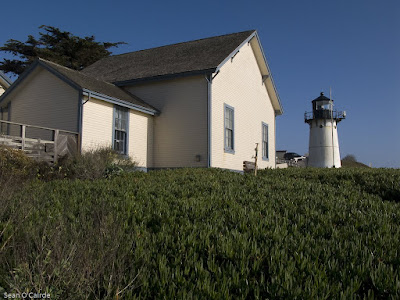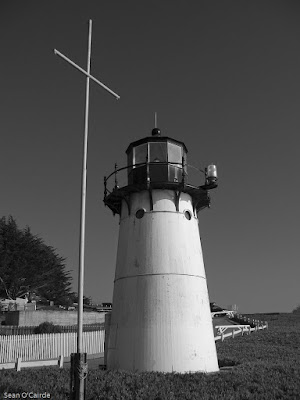
 Eddies back is keeping him house bound, and he is not able to make these last few trips. Its unfair to say its just his back, he is also recovering from a major operation on his arm and recuperating from a major bout of pneumonia. I am hoping he will have a speedy recovery.As these last lighthouse sites are local,15-20 Min's from our houses, and relatively easy to access, I don't mind coming back at a later stage to revisit, also to include him and his family. But I do miss having him and his family on these trips, it brings another dimension of excitement and chatter. But I feel if I stop journeying it will be hard to get motivated again. The weather will change, illness may occur, and things outside my control can happen. So I must press on, and come back again.
Eddies back is keeping him house bound, and he is not able to make these last few trips. Its unfair to say its just his back, he is also recovering from a major operation on his arm and recuperating from a major bout of pneumonia. I am hoping he will have a speedy recovery.As these last lighthouse sites are local,15-20 Min's from our houses, and relatively easy to access, I don't mind coming back at a later stage to revisit, also to include him and his family. But I do miss having him and his family on these trips, it brings another dimension of excitement and chatter. But I feel if I stop journeying it will be hard to get motivated again. The weather will change, illness may occur, and things outside my control can happen. So I must press on, and come back again. I want this lighthouse journey to be about the experience not just the lighthouse, the things we discover and the people we meet and the excitement of the kids. Also visiting these lighthouses gives another dimension of conversation for the kids, especially around their school friends, its something out of the ordinary and can enrich there lives. For me its also about photography, which is just one aspect as the updating of this blog.
I want this lighthouse journey to be about the experience not just the lighthouse, the things we discover and the people we meet and the excitement of the kids. Also visiting these lighthouses gives another dimension of conversation for the kids, especially around their school friends, its something out of the ordinary and can enrich there lives. For me its also about photography, which is just one aspect as the updating of this blog.
Today, Mark my son came with me, to the Lighthouse relief ship in Oakland. Its located near
 downtown in Jack London Square.About 20 Min's from my house. Parking was not too bad, $3.75 for about 2 hours. We arrived a little too late for the guided tours of the ship, but the guide was very helpful, he brought us aboard to look at the Fresnel lens, these where located below deck on the ship. He was full of information and gave me a copy of a lighthouse magazine.
downtown in Jack London Square.About 20 Min's from my house. Parking was not too bad, $3.75 for about 2 hours. We arrived a little too late for the guided tours of the ship, but the guide was very helpful, he brought us aboard to look at the Fresnel lens, these where located below deck on the ship. He was full of information and gave me a copy of a lighthouse magazine.Being so close to civilisation, there was no need to bring coffee or snacks on this trip. It was a day to show my son, another side of my life and to talk about him becoming a father, his wife Christina is expecting a baby in Feb 2009, that means I will be a granddad. he also just started a new job, and it gave us a chance to talk about it. A little different than my previous trips, who knows who may come on these trips.
Well today, there is no back country adventure, nor the beauty of the countryside or sea coastline, or the struggle to reach the lighthouse. No stories about seals , Pelicans, Animals that helped life around the lighthouse or wild keepers. No beaches or shells to gather, no off the track stores to wander in to. To be different, it was a
 downtown look at Oakland on the weekend. A part of the city I rarely visit. There was not much foot traffic around Jack London Square, but we had plenty of bay & harbor views.
downtown look at Oakland on the weekend. A part of the city I rarely visit. There was not much foot traffic around Jack London Square, but we had plenty of bay & harbor views.After visiting the ship, we spent a little time in Barnes & Nobles for a cup of coffee and a bisquati. Also watched a few ladies dressed in their red hats & a wedding on the pier. Took a walk along the harbor to the hut where Jack London lived in Alaska, and observed how they are putting in modern structures around Jack London's pub. Mark met a friend while we where at Jack London's pub.
 A little repetition, but when I arrived in Jack London square, The Sun was shining brightly, the
A little repetition, but when I arrived in Jack London square, The Sun was shining brightly, the  streets where empty, and it was easy to find parking in
streets where empty, and it was easy to find parking inClay Street. we had a short walk to the pier where the ship was docked. We saw a sign that pointed us in the direction of the ship. Not too many people around where in the vicinity of the ship. I could get a good view of the ship front and rear and a side view from the dock. I wish I could have found a way to get one from the water. But that will be for another day. We had arrived a little too late for the last tour, the tour of the ship is free. We met one of the volunteers and I explained to him that I was taking pictures of lighthouses in California, he kindly offered to take me aboard the ship and show me the Lens below deck.
He told us a little about the ship, the backup systems for both the Lens and the sirens. He also told us that the Fresnel Lens could not be used because of its directional light. The ship being tossed about the light would be pointing up in the air or down at the sea. He said the ship had a crew of 18 and only 12 would be onboard at any given time.
Also our stories where filled with sailors, high seas,
 rescues, and why the lights where mounted in the aft mast, and why the ship had back up lights and fog signals. All this added for a different look at the lighthouse. It was a long way from a man standing on a cliff, with a candle lamp, being a beacon to those seafarers who where in distress. The ship was fulfilling the same function at sea. It had more men, and it was in a more perilous situation, being tossed too and fro in a wild tempestuous sea.
rescues, and why the lights where mounted in the aft mast, and why the ship had back up lights and fog signals. All this added for a different look at the lighthouse. It was a long way from a man standing on a cliff, with a candle lamp, being a beacon to those seafarers who where in distress. The ship was fulfilling the same function at sea. It had more men, and it was in a more perilous situation, being tossed too and fro in a wild tempestuous sea.History
The WLV 695 was one of 6 ships built in 1950 for the Coast Guard. In was
 built in Maine by the Rice Brothers Shipyard and commissioned in 1951 as a lightship station near Delaware. The W designates it as a Coast Guard Vessal, the L as a lightship, the V for vessal. The name RELIEF was painted on the side of the ship. It releived a station ship came in for maintenance. It is 128ft long, 30ft beam, and 11ft draft. The ship was dogged by mishaps, a fire, running aground, before being launched in 1950. It carried a pair of 374 mm 500,000 candlelight powered lens, a pair of diaphone fog signal, a radar, and a radio beacon. The lights could be seen for 23 miles, and where mounted on the foremast. One of the pairs of lights was used as a backup.
built in Maine by the Rice Brothers Shipyard and commissioned in 1951 as a lightship station near Delaware. The W designates it as a Coast Guard Vessal, the L as a lightship, the V for vessal. The name RELIEF was painted on the side of the ship. It releived a station ship came in for maintenance. It is 128ft long, 30ft beam, and 11ft draft. The ship was dogged by mishaps, a fire, running aground, before being launched in 1950. It carried a pair of 374 mm 500,000 candlelight powered lens, a pair of diaphone fog signal, a radar, and a radio beacon. The lights could be seen for 23 miles, and where mounted on the foremast. One of the pairs of lights was used as a backup.The ship had a pair of anchors, 5000lb and a 6500 lb. One was used when the ship was being used as a station. It carried a 1170 ft chain, used when the ship was a station. The 605 ship was built with a pair of engine rooms, One was used when the ship was used as a light station, the other engine room was used when the ship was underway. The engine room B-1 was used on the light station and is equipped with a pair of boilers, generators, air compressors and water heaters. The engine room B-2 contains backup systems, and the ship's main propulsion engine. This was a 550 hp, 8 cyclinder diesel engine and could reverse direction. The ship could get upto a top speed of 11.5 knots.
1960 the ship was transferred to Cape Mendocino in California. Finally in 1969 the ship became a relief ship to all West coast lightships. 1975 was decommissioned , 1979 was sold to a Mr Hosking of Woodside California. He donated the the Ship to the United States Lighthouse Society in 1986, 1987 under her own power from Half Moon Bay the ship sailed into 9th street terminal in Oakland harbour. The next 15 years was spent in restoring the ship to her 1951 appearance. Thousands of volunteer hours was dedicated. In June 2002 she was opened to the public. The WLV 605 is the last known relief ship in existence. The volunteers and the Society has done a tremendous job in restoration. The more I visit these beacons, the I see the place they have in peoples lives. Their is a connection that is hard to explain, once these lights protected us from the dangers of the seas and rocks and now we must protect them from extinction.
References
The United States Lighthouse Society










